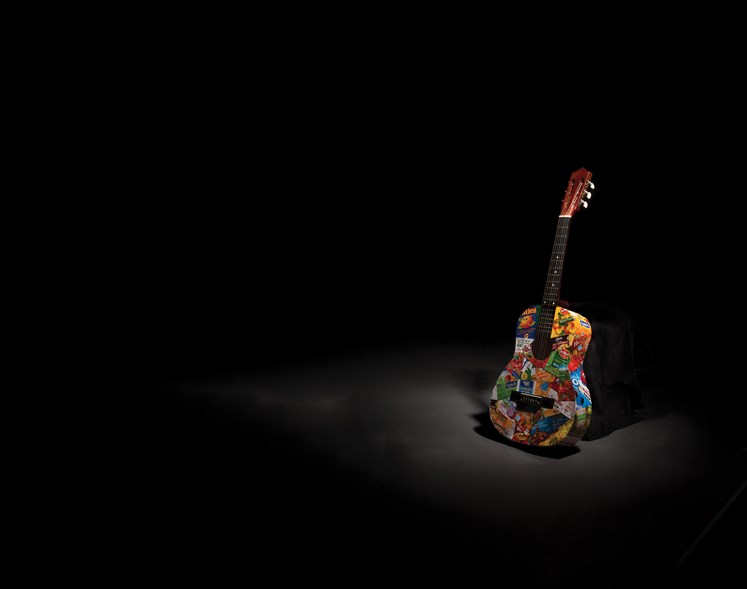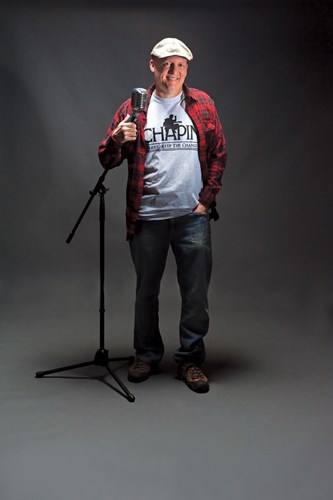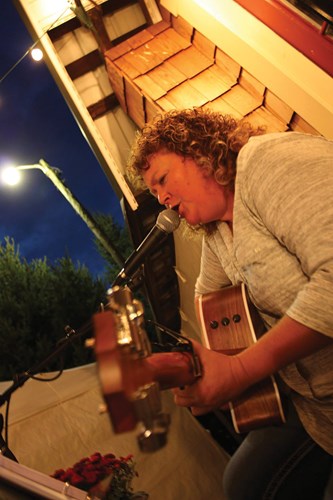Alumni Resources
About the University
By C.L. Stambush

I love the dynamic and surprisingly seamless mix of self-deprecating (and sometimes poignant) humor and eclectic music, and the way that this combination brings life to the stories shared in sounds and words. —Jen Chapin, Singer/ Songwriter/Producer, Recording and Performing Artist
The ring of Scott Saalman’s cellphone breaks the silence and before answering it he says, “Here comes our first crisis.”
The caller is one of 10 performers slated for tonight’s Will Read and Sing for Food show, benefiting United Caring Services, Saalman’s 96th “listening show” that he’s put together in the past five years to raise funds for local charities.
Stepping away, Saalman provides the lost singer/songwriter with sketchy directions to the venue’s location, saying, “It’s at the Arts Council on Main Street.” Their conversation drags on as Saalman, a 1987 communications major, warns the wandering minstrel that the street is blocked off—some band is outside playing for a store’s grand opening—and he should park in the nearby city garage.
The gritty sounds of free street music filter into the hushed and empty Bower-Suhrheinrich Foundation Gallery as Saalman ends the call. The competition outside feels like a wolf at his door, and he’s worried he’ll fail tonight’s benefit charity if no one comes to his show. “They’ve got some guy from The Voice!” he says, his eyes raking over the 80 seats he hopes will fill for $10 each as he looks toward the street.
The musicians and writers for Saalman’s show begin to arrive, including Jason Wilber, Grammy-award-winning John Prine’s guitar “guy” for the past 20 years, who steals into the room wearing a wool cap and a sheepish grin before settling into his seat to run a riff on his parlor guitar. The lost musician, Kyle Lueken, arrives too and sets up mic stands and cords he pulls from crates Saalman hauled from Jasper, Indiana, in his stuffed-to-the-gills 2010 Corolla. “Everybody has a job to make the show come together,” Saalman says, as he rushes past; the blur of a man on a mission.

EARLY DAZE
Growing up in Tell City, Indiana, Saalman wanted to be different, but knew he’d never separate himself from the herd in the traditional way boys did, by becoming a star football player, so he began to distinguish himself with words. A precocious reader, he traded Stephen King novels with his 6th grade teachers before advancing to write his own disturbing stories while riding the school bus—a horrifying experience itself, he assures. “Stephen King. He was it.”
By the time he hit his teens, his wordsmithing proclivities had morphed into penning lyrics. “I say song lyrics because I’m not a poet. AT ALL,” noting instead it was about “getting chicks,” an endeavor that persists today, he says, half joking.
Saalman’s home life was filled with love, literature and music: his mom an avid reader and his dad (who never read a book) a guitarist. Today, they’re his most ardent fans, attending 96 out of 106 shows. But they taught him more than love of the arts, they instilled in him the seed of caring. “I come from a family who wants to help others who are less fortunate,” he says.
By the time Saalman reached college age, he’d filled a dozen notebooks with his writing, but felt a better future rested in business, so the firstgeneration college student headed for Western Kentucky University. He made the Dean’s List his first semester before plummeting to academic probation his second semester due to “too much Euchre,” he says. “I quickly learned business and numbers weren’t for me.”
INFLUENCERS
Saalman’s life changed when he transferred to USI, where he learned it was possible to make a living doing what he loved most when he met Ron Roat, instructor of journalism (now deceased) and longtime advisor for The Shield (USI’s student newspaper). “He took me under his wing and introduced me to journalism, not PR or broadcast, but true-blue newspaper journalism,” he says.
It was the 1980s, computers were replacing typewriters, and Saalman says Roat was determined to equip him for success. “That was the greatest thing,” said Saalman, who contributed to The Shield, “to have a professor believe so much in my future…that he made me buy a computer. He drove me to Target, walked me through the store and showed me what to buy.”
Roat wasn’t the only faculty member who had a hand in fashioning Saalman. But, given his aversion to poetry—an art form (along with fiction) he excludes in his events because “most poetry sucks and the readings need to be funny and true”—it’s odd, then, that the other USI professor to shape his thinking would be poet Matthew Graham, professor of English. Their mentor/mentee relationship became so deep over the years, that Graham is the only person Saalman allows to recite verse at the events. “Matthew opened my mind to truly great contemporary literature, pulling me from the Stephen King-type novels of my adolescence,” Saalman says. “He changed the focus not only on what I read, but what I wrote. Updike. Cheever. Carver. I wanted to write like them.”
But Saalman loved journalism too. “My first byline (outside of The Shield) appeared in The Coconut Telegraph, a Jimmy Buffettowned publication in Key West,” he says, adding Buffett was another influence in his writing career. “I saw my byline and was hooked.”
After graduating from USI, Saalman began reporting for the Princeton Daily Clarion before jumping to The Herald in Dubois County. Aspirations for a journalistic career led him to migrate to the Newport News Daily Press and Times Herald in Newport News, Virginia, as the lead feature writer, “a soul-sucking, corporate-cutthroat world” he hated. When Kimball International reached out with an internal communication’s position, he jumped at the opportunity, thinking, “Yea, I’ll cross over to the other side.” Twenty-six years later, Saalman, communications director, still loves his work at Kimball Electronics, headquartered in Jasper, Indiana, where he’s grown into a one-man media/multimedia machine, writing blog posts, newsletters, news releases, and editing video while occasionally traveling to the company’s international locations.
UNDERDOG UPRISING
Grocery sacking at a community food bank and singer/ songwriter Harry Chapin are the reasons Saalman began Will Read and Sing for Food. “In the early 80s, I’d wanted to go to a Chapin concert in Evansville. Harry encouraged people to bring a canned food,” he says. “That always stuck with me.”
Chapin, famous for his heart-twisting folk songs and social crusades, used his concerts to raise money to combat hunger in the United States (he died in 1981). “He got to where he’d do one show for himself and one show to benefit a charity,” says Saalman. This underdog activism resonated with him, and one night as he put nonperishables into a bag for someone who would otherwise go hungry, he thought, “Anybody can sack these groceries. What can I do that others can’t, or aren’t, to help this place?” His essays had been published in a variety of regional and national magazines, journals and anthologies, and he’d written bi-weekly humor essays (his “true calling”) for The Herald for several years. Plus, he’d participated in public readings. “I thought, maybe I could use that talent, the only one I have— if it’s a talent at all—to help the food bank.”

Six seasons, 106 shows, 100-plus musicians and writers and 33 charities later, Saalman has raised $102,160, surpassing his ultimate goal of $100,000. “It’s addicting, seeing those donation dollars go up,” he says.
It ’s a passion project. – Scott Saalman
Addicting and exhausting, as Saalman performs every role in putting together what he humbly calls “a silly little show,” including publicist, roadie, manager, venue scout, booking agent, performer and more. The shows (think Garrison Keillor’s “Prairie Home Companion”) feature a diversity of talent and sound, from the island beats of Zion’s reggae rhythms, to the strums of Lueken’s satirical songs, to the tenor of Evansville Courier & Press columnist Jon Webb’s ’09 unapologetic essays. Each fundraiser delivers a new show, as the talent performing is different each time. The shows have grown and generated so much good, that Graham nominated Saalman’s Will Read and Sing for Food for the Arts Council of Southwestern Indiana’s 2016 Mayor’s Arts Award, an honor it won.
Over the years, Saalman’s events have featured musicians and writers from near and far—including Harry Chapin’s daughter Jen Chapin and her band; a full-circle moment for Saalman. Those involved in the shows share a common goal of performing publicly to aid an underdog. Their motivation isn’t all altruistic, however, and Saalman admits it’s an opportunity to be heard and to hear the laughter. “This is the most fun and worthwhile thing I’ve ever done with my writing.” The shows, which in the beginning asked for canned goods only, have garnered as little as $77 and as much as $17,5501 . “On one occasion, there were more performers than audience due to a snow storm,” says Saalman. “Mother Nature has better PR than I do.”

CURTAIN CALL
Saalman emerges five minutes before show time, having shed his casual attire for creased slacks, a crisp dress shirt and silver tie, and takes his seat next to his cohost, WNIN’s Paola Marizan ’16. Together, their easy banter steers the full house through 90 minutes of song and humor, while Saalman bounces between bouts of emceeing, videoing the performers for Will Read and Sing for Food’s website and Facebook pages, and reading three humor essays of his own.
The Evansville show, one of the few outside of Dubois County, breaks $800, a figure that in the world of fundraising might seem minuscule to some but not Saalman. “It’s a respectable number,” he says. “When it’s less, I feel bad for the charity, because we could have raised more money.”
Dollar-by-dollar, show-by-show, Saalman hosts events to raise funds focused on helping local, small charities as opposed to national organizations. “I want to keep it local because I know where the money goes, and the good it will do for organizations like a small library,” he says, and then, after a long pause he adds almost inaudibly, “So, we quietly make noise.”
There was a Rotary Club show in Jasper, Indiana, to help the club raise funds to cure polio. The show raised $3,900 and the money was matched by Bill and Melinda Gates Foundation and Rotary International, bringing the total to $17,550.
If you enjoyed this story, let us know at magazine@usi.edu.